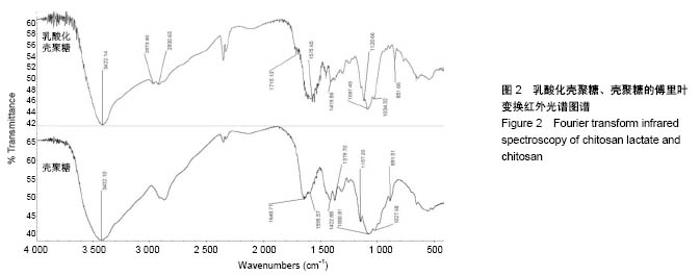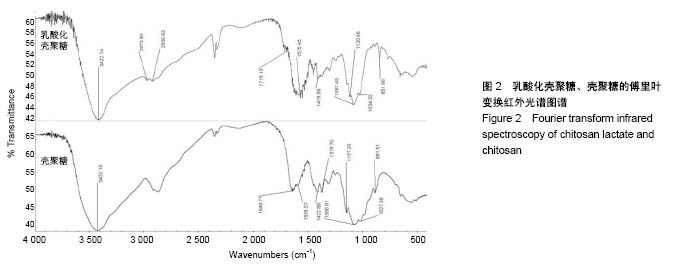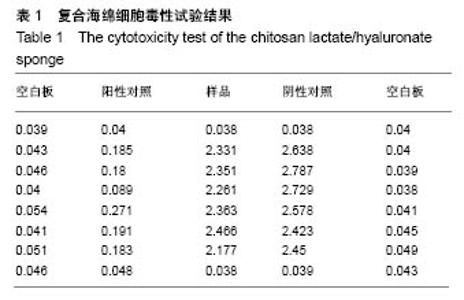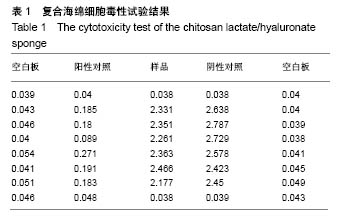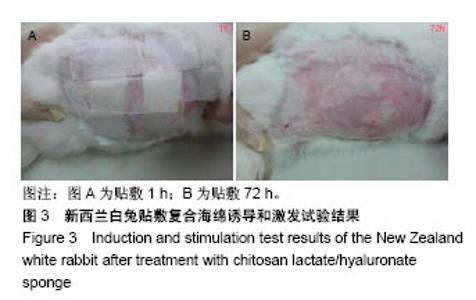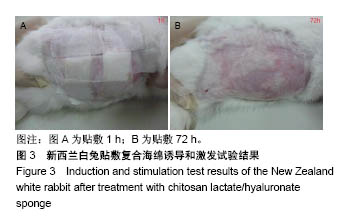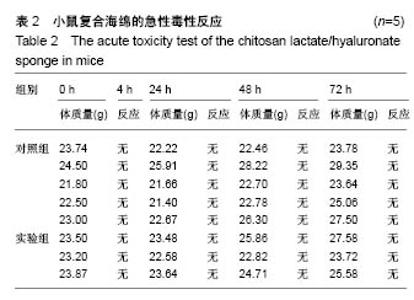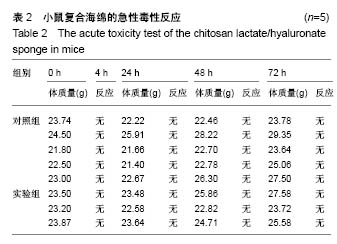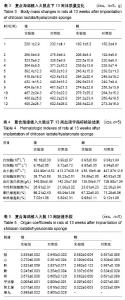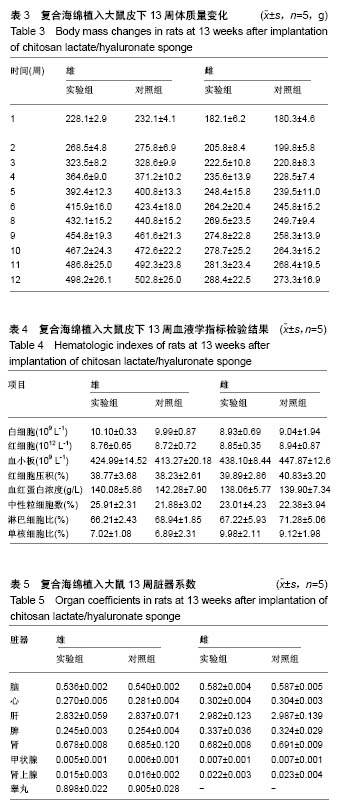Chinese Journal of Tissue Engineering Research ›› 2019, Vol. 23 ›› Issue (10): 1558-1563.doi: 10.3969/j.issn.2095-4344.1628
Previous Articles Next Articles
Biosafety evaluation of chitosan lactate/hyaluronate sponge
Cai Yuhui, Hu Kesu, Zhang Yi
- Department of Burn and Plastic Surgery, Affiliated Hospital of Nantong University, Nantong 226001, Jiangsu Province, China
-
Received:2018-11-24Online:2019-04-08Published:2019-04-08 -
Contact:Zhang Yi, MD, Chief physician, Department of Burn and Plastic Surgery, Affiliated Hospital of Nantong University, Nantong 226001, Jiangsu Province, China -
About author:Cai Yuhui, Master, Associate chief physician, Department of Burn and Plastic Surgery, Affiliated Hospital of Nantong University, Nantong 226001, Jiangsu Province, China -
Supported by:the Scientific Research Program of Jiangsu Provincial Health and Family Planning Commission, No. H201625 (to ZY); Nantong Key Technology Research Program, No. MS22016042 (to CYH)
CLC Number:
Cite this article
Cai Yuhui, Hu Kesu, Zhang Yi. Biosafety evaluation of chitosan lactate/hyaluronate sponge[J]. Chinese Journal of Tissue Engineering Research, 2019, 23(10): 1558-1563.
share this article
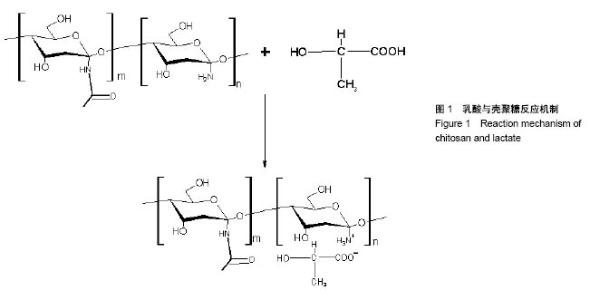
2.1 实验动物数量分析 实验选用小鼠10只,大鼠30只,兔3只,实验过程无脱失,全部进入结果分析。 2.2 傅里叶变换红外光谱结果 乳酸和壳聚糖的反应机制显示,当壳聚糖溶于乳酸溶液时,壳聚糖中氨基质子化、并与乳酸中羧基发生反应形成乳酸铵盐,见图1。傅里叶变换红外光谱测试结果表明,壳聚糖图中1 157.5 cm-1和891.51 cm-1是壳聚糖β(1-4)糖苷键的特征吸收峰;在乳酸化壳聚糖的图中该吸收峰发生一定蓝移,这是由于壳聚糖的氨基与乳酸的羧基发生了较强氢键作用造成的,见图2。 图2中壳聚糖和乳酸化壳聚糖有明显区别:①乳酸化壳聚糖中1 575.65 cm-1处为羧基中羰基的伸缩振动特征峰;②2 930-2 973.0 cm-1为乳酸中羟基的伸缩振动特征峰;③在1 715 cm-1左右出现的新吸收峰,是由于乳酸接枝形成的侧链;④乳酸化壳聚糖在1 575 cm-1处的吸收峰明显增强,这些均证明壳聚糖和乳酸发生了共价结合,生成了酰胺基[25]。"
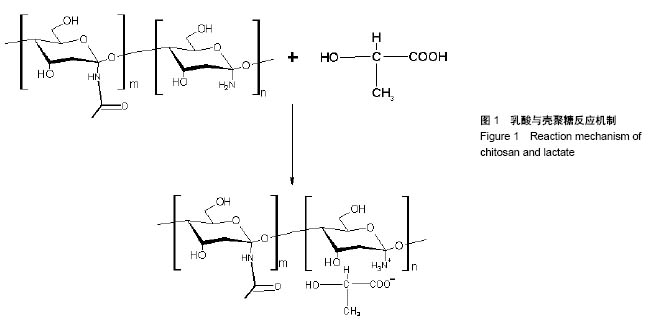
| [1] 赵琳,宋建星.创面敷料的研究现状与进展[J]. 中国组织工程研究与临床康复.2007,11(9):1724-1726.[2] 孔易,徐瑞.壳聚糖/藻酸盐纳米膜在促进小鼠全层损伤皮肤创面愈合中的作用[J].第三军医大学学报.2015,37(21):2109-2114. [3] 王竞男,罗嘉浩,杨立群,等.壳聚糖及其衍生物在药物载体方面的研究进展.转化医学杂志[J].2017,6(4):193-198. [4] 刘琳娜,李学拥,赵聪颖,等.壳聚糖护创敷料用于深Ⅱ度烧伤创面的疗效和安全性:一项前瞻性、随机、单盲、阳性对照临床试验[J].中国组织工程研究,2017,21(14):2222-2226.[5] 蔡少甫,余昌龙.壳聚糖联合纳米银医用抗菌敷料治疗老年Ⅱ度烧伤创面的疗效观察[J].中国社区医师,2016,32(6):78-79.[6] Oana MD,Sangran KS,Mamoni D,et al. New antimicrobial chitosan derivatives for wound dressing Applications. Carbohydrate Polymers. 2016;141: 28-40.[7] Chanphai P, Tajmir-Riahi HA. Chitosan nanoparticles conjugate with trypsin and trypsin inhibitor. Carbohydr Polym. 2016;144: 346–352.[8] Ngo DH, Vo TS, Ngo DN, et al. Biological effects of chitosan and its derivatives. Food Hydrocolloids. 2015,51: 200–216. [9] Pereira VA, Queiroz de Arruda IN, Stefani R. Active chitosan/PVA ?lms with anthocyanins from Brassica oleraceae(Red Cabbage) as time–temperature indicators for application in intelligent food packaging. Food Hydrocolloids. 2015;43:180–188.[10] HaHaitang Xu, Lie Ma,Haifei Shi,et al. Chitosan–hyaluronic acid hybrid film as a novel wound dressing: in vitro and in vivo studies. Polym. Adv. Technol. 2007; 18: 869-875.[11] Younes I,Rinaudo M.Chitin and chitosan preparation from marine sources.Structure,properties and application.Mar Drugs.2015;13(3):1133-1174.[12] Rinaudo M,Le Dung P, Gey C, et al. Substituent distribution on O,N-carboxymethylchitosans by 1H and 13C n.m.r. Int J Bilo Macromol.1992;12:122.[13] Muzzarelli RA, Tanfani F, Emanuelli M, et al.Sulfated N-(carboxymethyl)chitosans: novel blood anticoagulants. Carbohydr Res.1984;126(2):225-231.[14] Park IK, Yang J, Jeong HJ, et al. Galactosylated chitosan as a synthetic extracellular matrix for hepatocytes attachment. Biomaterials. 2003;24(13):2331-2337.[15] Khan TA, Peh KK, Ch'ng HS.Reporting degree of deacetylation values of chitosan: the influence of analytical methods.J Pharm Pharm Sci. 2002;5(3):205-212.[16] Seyed YV, Motahareh E, Mohsen A,et al. Self assembled hyaluronic acid nanoparticles as a potential carrier for targeting the in?amed intestinal mucosa. Carbohydrate Polymers. 2016;144: 371–381.[17] Chang JE, Cho HJ, Yi E, et al. Hypocrellin B and paclitaxel-encapsulated hyaluronic acid–ceramide nanoparticles for targeted photodynamic therapy in lung cancer. J Photochem Photobiol B. 2016;158:113-121.[18] Ramos-Torrecillas J, Garcia-Martinez O,Luna-Bertos ED,et al. Effectiveness of platelet-rich plasma and hyaluronic acid for the treatment and care of pressure ulcers. Biol Res Nurs. 2015;17 (2): 152-158.[19] Dalmedico MM, Meier MJ, Felix JV, et al. Hyaluronic acid covers in burn treatment a systematic review. Rev Esc Enferm USP. 2016;50(3): 519-524. [20] Choi YS, Hong SR, Lee YM, et al.Studies on gelatin-containing artificial skin: II. Preparation and characterization of cross-linked gelatin-hyaluronate sponge.J Biomed Mater Res.1999;48(5):631-639.[21] Duranti F, Salti G, Bovani B, et al. Injectable hyaluronic acid gel for soft tissue augmentation. A clinical and histological study. Dermatol Surg. 1998;24(12):1317-1325.[22] Radomsky ML, Aufdemorte TB, Swain LD, et al. Novel formulation of fibroblast growth factor-2 in a hyaluronan gel accelerates fracture healing in nonhuman primates.J Orthop Res. 1999;17(4):607-614.[23] Brow MB, Siligardi G,Karim S, et al//Fourth international workshop on hyaluroman in drug delivery, willough by , d., ed. RSM prss, London.1996:79.[24] Yang B, Yang BL, Savani RC, et al.Identification of a common hyaluronan binding motif in the hyaluronan binding proteins RHAMM, CD44 and link protein.EMBO J. 1994;13(2): 286-296.[25] 于飞,奚廷婓,张姝江,等. 具有垂直孔道的壳聚糖乳酸盐海绵的制备及体外释药模型的拟合分析[J]. 高等学校化学学报, 2012, 33(4):843-849.[26] 李娜梅,杨飒,宁倩,等.半乳糖化壳聚糖—氟尿嘧啶偶合物纳米给药体系的制备、表征及体外性能研究[J].南华大学学报(自然科学版), 2015,29(3):82-91.[27] 顾秋忠,陆照林,翁辞海,等.透明质酸钠在腹盆腔手术中预防粘连的临床研究.中华全科医学[J].2015,13(4): 579-581.[28] 朱香利.壳聚糖生物医用材料的应用[J].中外医疗, 2013,(14): 12-14. |
| [1] | Zhang Tongtong, Wang Zhonghua, Wen Jie, Song Yuxin, Liu Lin. Application of three-dimensional printing model in surgical resection and reconstruction of cervical tumor [J]. Chinese Journal of Tissue Engineering Research, 2021, 25(9): 1335-1339. |
| [2] | Zeng Yanhua, Hao Yanlei. In vitro culture and purification of Schwann cells: a systematic review [J]. Chinese Journal of Tissue Engineering Research, 2021, 25(7): 1135-1141. |
| [3] | Xu Dongzi, Zhang Ting, Ouyang Zhaolian. The global competitive situation of cardiac tissue engineering based on patent analysis [J]. Chinese Journal of Tissue Engineering Research, 2021, 25(5): 807-812. |
| [4] | Wu Zijian, Hu Zhaoduan, Xie Youqiong, Wang Feng, Li Jia, Li Bocun, Cai Guowei, Peng Rui. Three-dimensional printing technology and bone tissue engineering research: literature metrology and visual analysis of research hotspots [J]. Chinese Journal of Tissue Engineering Research, 2021, 25(4): 564-569. |
| [5] | Li Li, Ma Li. Immobilization of lactase on magnetic chitosan microspheres and its effect on enzymatic properties [J]. Chinese Journal of Tissue Engineering Research, 2021, 25(4): 576-581. |
| [6] | Chang Wenliao, Zhao Jie, Sun Xiaoliang, Wang Kun, Wu Guofeng, Zhou Jian, Li Shuxiang, Sun Han. Material selection, theoretical design and biomimetic function of artificial periosteum [J]. Chinese Journal of Tissue Engineering Research, 2021, 25(4): 600-606. |
| [7] | Liu Fei, Cui Yutao, Liu He. Advantages and problems of local antibiotic delivery system in the treatment of osteomyelitis [J]. Chinese Journal of Tissue Engineering Research, 2021, 25(4): 614-620. |
| [8] | Li Xiaozhuang, Duan Hao, Wang Weizhou, Tang Zhihong, Wang Yanghao, He Fei. Application of bone tissue engineering materials in the treatment of bone defect diseases in vivo [J]. Chinese Journal of Tissue Engineering Research, 2021, 25(4): 626-631. |
| [9] | Zhang Zhenkun, Li Zhe, Li Ya, Wang Yingying, Wang Yaping, Zhou Xinkui, Ma Shanshan, Guan Fangxia. Application of alginate based hydrogels/dressings in wound healing: sustained, dynamic and sequential release [J]. Chinese Journal of Tissue Engineering Research, 2021, 25(4): 638-643. |
| [10] | Chen Jiana, Qiu Yanling, Nie Minhai, Liu Xuqian. Tissue engineering scaffolds in repairing oral and maxillofacial soft tissue defects [J]. Chinese Journal of Tissue Engineering Research, 2021, 25(4): 644-650. |
| [11] | Xing Hao, Zhang Yonghong, Wang Dong. Advantages and disadvantages of repairing large-segment bone defect [J]. Chinese Journal of Tissue Engineering Research, 2021, 25(3): 426-430. |
| [12] | Chen Siqi, Xian Debin, Xu Rongsheng, Qin Zhongjie, Zhang Lei, Xia Delin. Effects of bone marrow mesenchymal stem cells and human umbilical vein endothelial cells combined with hydroxyapatite-tricalcium phosphate scaffolds on early angiogenesis in skull defect repair in rats [J]. Chinese Journal of Tissue Engineering Research, 2021, 25(22): 3458-3465. |
| [13] | Wang Hao, Chen Mingxue, Li Junkang, Luo Xujiang, Peng Liqing, Li Huo, Huang Bo, Tian Guangzhao, Liu Shuyun, Sui Xiang, Huang Jingxiang, Guo Quanyi, Lu Xiaobo. Decellularized porcine skin matrix for tissue-engineered meniscus scaffold [J]. Chinese Journal of Tissue Engineering Research, 2021, 25(22): 3473-3478. |
| [14] | Mo Jianling, He Shaoru, Feng Bowen, Jian Minqiao, Zhang Xiaohui, Liu Caisheng, Liang Yijing, Liu Yumei, Chen Liang, Zhou Haiyu, Liu Yanhui. Forming prevascularized cell sheets and the expression of angiogenesis-related factors [J]. Chinese Journal of Tissue Engineering Research, 2021, 25(22): 3479-3486. |
| [15] | Li Xinping, Cui Qiuju, Zeng Shuguang, Ran Gaoying, Zhang Zhaoqiang, Liu Xianwen, Fang Wei, Xu Shuaimei. Effect of modification of β-tricalcium phosphate/chitosan hydrogel on growth and mineralization of dental pulp stem cells [J]. Chinese Journal of Tissue Engineering Research, 2021, 25(22): 3493-3499. |
| Viewed | ||||||
|
Full text |
|
|||||
|
Abstract |
|
|||||
